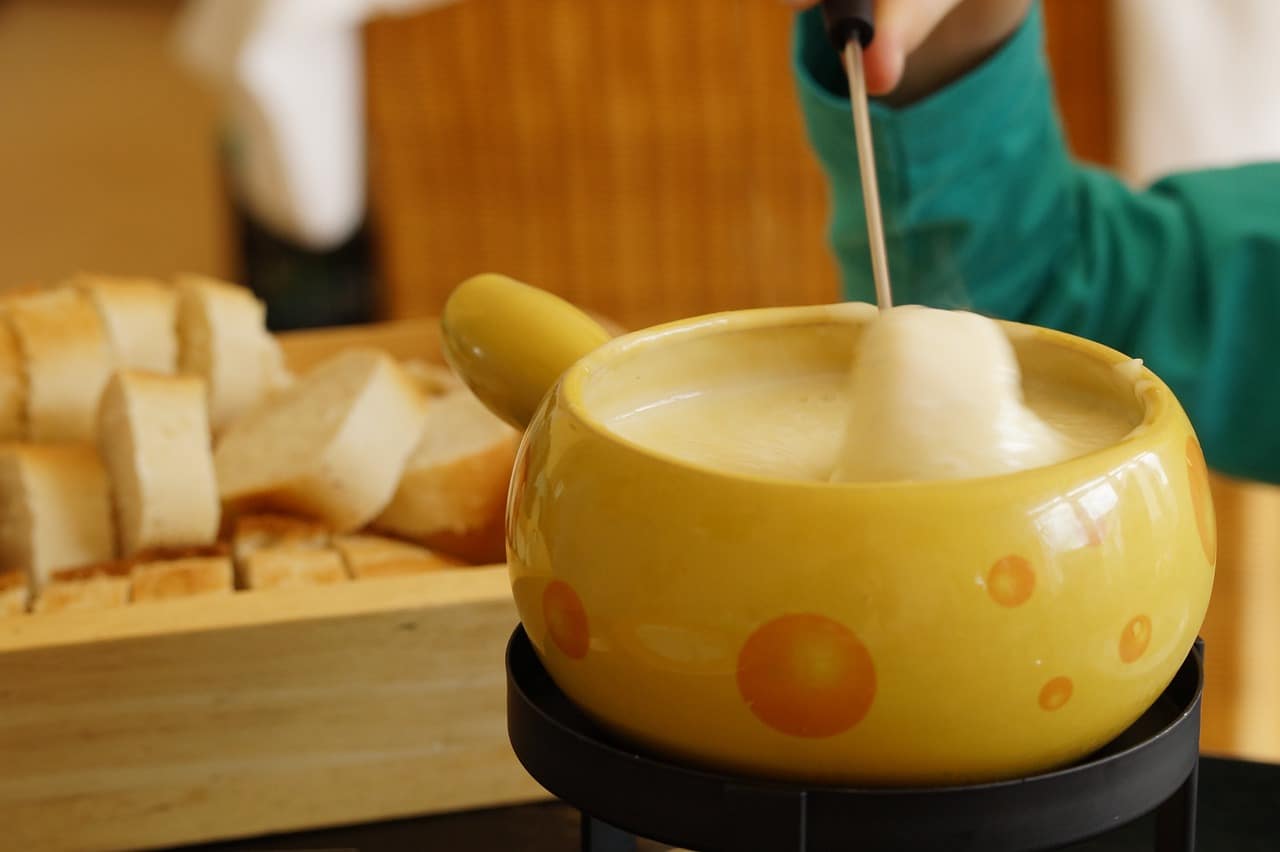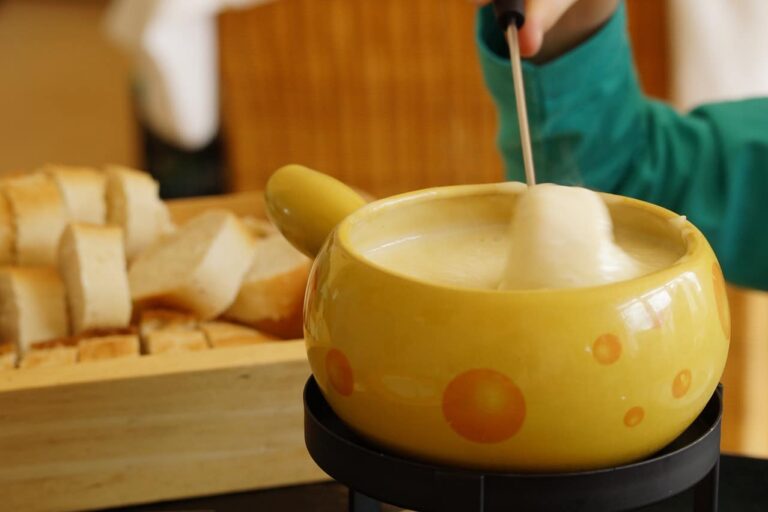
Fondue, one of Switzerland’s national dishes, is a culinary delight that has captured hearts worldwide. This warm, melted cheese dish is not just food; it’s an experience—a social event that brings people together.
Our team at Remitly created this guide as part of our series that celebrates the traditional foods of our global customers.
Origins of Fondue
The origin of fondue can be traced back to the Swiss Alps. It was initially a humble meal created by shepherds and farmers using ingredients they had on hand: cheese, wine, and crusty bread.
The name “fondue” comes from the French word “fondre,” which means “to melt.” This simple yet delicious dish was a practical solution for utilizing hardened cheese and stale bread during harsh winter months.
Key Ingredients
Traditional Swiss fondue uses two types of Swiss cheese: Gruyère and Emmental. These cheeses are known for their melting qualities and distinct flavors. White wine is added to provide acidity, which helps in melting the cheese smoothly. Garlic is rubbed inside the pot for subtle flavoring while kirsch—a cherry brandy—is often included for an extra kick.
Swiss fondue has many variations depending on regional preferences. In some parts of Switzerland, mushrooms or tomatoes are added to the mix. Other regions prefer using different types of grated cheeses like Vacherin Fribourgeois or Appenzeller.
Making Fondue
Making fondue is an art in itself. The process begins with rubbing garlic around the inside of a special pot called a caquelon. Cheese is then grated or cut into small pieces and mixed with cornstarch to prevent clumping when melted. Wine is heated in the caquelon until hot but not boiling; then, the cheese mixture is gradually added while stirring constantly until smooth and creamy.
Swiss Cheese Fondue Recipe
Classic cheese fondue is a dish that’s easy to prepare and enjoy at home. Here’s a simple recipe for traditional Swiss fondue.
Ingredients:
- 200g Gruyère cheese
- 200g Emmental cheese
- 1 clove garlic
- 300ml dry white wine
- 2 teaspoons cornstarch
- 3 tablespoons kirsch (cherry brandy)
- Freshly ground black pepper
- Freshly grated nutmeg
- 1 French baguette (sourdough works too)
Instructions:
- Grate the Gruyère and Emmental cheese and mix them together in a bowl.
- Cut the garlic clove in half and rub the inside of the fondue pot with it.
- Pour the wine into the pot and heat gently until hot, but not boiling.
- Gradually add the shredded cheese, stirring constantly until melted and smooth.
- In a small bowl, blend the cornstarch smoothly with the kirsch, then stir into the cheese mixture.
- Continue to cook gently, stirring constantly until thickened.
- Season with pepper and nutmeg to taste.
- Cut bread into bite-sized cubes and serve with fondue.
Serving Fondue at Social Gatherings
Fondue is popular during special occasions in Switzerland. It’s often enjoyed during Christmas holidays, on New Year’s Eve, or at family gatherings, as it encourages conversation and camaraderie.
Serving fondue involves certain etiquette rules that add fun to this communal eating experience. A long-stemmed fork is used to spear a piece of bread, which is then dipped into the molten cheese mixture—twirling it slightly ensures an even coating without losing your bread cubes in the pot. It’s considered bad form to double-dip, and there’s a playful rule that if you drop your bread in the pot, you must forfeit that piece.
Global Popularity
The influence of Swiss fondue has spread worldwide. In particular, fondue has carved a niche for itself in the American culinary landscape since its introduction to the USA in the 1960s. It quickly became a staple at American dinner parties as both an appetizer and a main course, symbolizing a blend of sociability and indulgence.
The traditional fondue set, complete with fondue forks, became a common sight in American households, often brought out to entertain guests at a “fondue party,” with dippers from classic French bread to veggies.
Chocolate fondue also saw a surge in popularity, served up after a round of drinks, sometimes in a colorful electric fondue pot. The dippers for chocolate fondue extended to strawberries, marshmallows, and pieces of cake.
Over the years, several fondue restaurants have sprung up across the country, ranging from high-end to kitschy.
Fondue and Nutrition
The healthiness of fondue largely depends on the ingredients used and the quantity consumed. Traditional cheese fondue is high in fat and calories due to the cheese and is often accompanied by bread, which is high in carbohydrates. Similarly, chocolate fondue is indulgent, being rich in sugars and fats.
However, incorporating various dippers can add nutritional value to the meal. Moderation is key when enjoying fondue, as with any dish high in fats, sugars, and calories.
Here are some tips for enjoying a healthier fondue:
– Opt for lower-fat cheeses and dark chocolate to reduce calorie intake.
– Limit portion sizes to avoid overindulgence.
– Be mindful of what you’re dipping into the fondue.
– Choose healthier dippers such as:
* Fruits
* Vegetables
* Lean meats
* Whole-grain breads
Avoid less healthy options like marshmallows or heavily processed meats.
The Cuisine of Switzerland
Swiss cuisine is as diverse as its landscapes—each region has its unique dishes influenced by neighboring countries like Italy, France, and Germany.
Cheese Dishes
Apart from fondue, Switzerland is famous for other cheese-based dishes such as raclette—a semi-hard cheese melted on a special grill—and rosti—a crispy potato pancake often topped with melted raclette.
Meat Dishes
Meat plays an important role in Swiss cuisine too. Zürcher Geschnetzeltes—thin strips of veal cooked in a creamy white wine sauce—is a popular dish from German-speaking Zurich while sausages are enjoyed throughout Switzerland.
Desserts
Switzerland is renowned for its chocolates and pastries. Swiss chocolate, with its smooth texture and rich flavor, is appreciated worldwide. Pastries like Nusstorte—a nut-filled pastry from Engadine—and Lebkuchen—Swiss gingerbread—are also well known.
Beverages
When it comes to beverages, Switzerland offers a variety of wines produced in regions like Valais and Vaud. Non-alcoholic drinks include Rivella—a soft drink made from milk whey—and Ovomaltine, a popular malted drink often enjoyed as a hot beverage.
Swiss cuisine reflects the country’s rich cultural diversity. From hearty cheese dishes to delicate pastries, there’s something for everyone in this Alpine nation’s culinary repertoire.
Visit the homepage, download our app, or check out our Help Center to get started.
